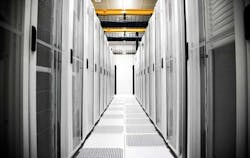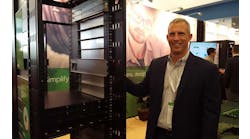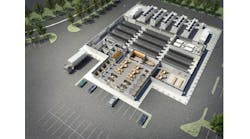Data Centers on the Edge: Streaming and IoT Reshape the Network
You hate it when your Netflix movies are buffering. So does Netflix, and its rivals in the streaming video business.
But it’s a hard problem to eradicate. A global survey of 50 billion streaming experiences in 2014 found that rebuffering occurred on about 29 percent of all streams.
Hunter Newby hates buffering, too. So he’s working to bring that video closer to your house, shortening the distance data must travel over the network.
Newby, the CEO of Allied Fiber, is building fiber routes and colocation facilities where they haven’t been seen before. An example: A new fiber route starts at a traffic exchange point in a Neflix facility in Miami, runs north along the coast of Florida and up to Atlanta. Every 60 miles there’s a small colocation facility for network equipment and servers where customers can cache data in places like Hahira, Georgia and Rockledge, Florida.
This makes Netflix and other video services “faster, better and cheaper,” said Newby, “Distributing content to mobile end points is the game.”
And the game is changing. Content providers – including media companies, retailers, financial services firms and sports leagues – are racing to keep pace with the explosion of Internet video and mobile devices.
This is the second in a series of stories at Data Center Frontier on the changing data center geography of the United States. Part one looked at the increasingly wired nature of business and how it’s driving demand for data center services in smaller cities and towns. Today, we look at the data-hungry consumer and their impact on where content resides on the Internet.
An ‘Explosion’ of Data at the Edge
A key strategy in addressing latency (often referred to as “lag”) is moving streaming video closer to the edge of the network, which has huge implications for Internet infrastructure.
“It’s very important that content gets to the edge user,” said Clint Heiden, Chief Commercial Officer of EdgeConneX. ‘The adoption of cloud simply means that the cloud must grow and move to the edge. To be robust, it’s got to be able to offer performance.”
EdgeConneX specializes in edge content distribution. Since late 2013, the company has deployed 23 data centers and more than 3,000 points of presence (PoPs) across the U.S. It’s not alone in seeing demand for data center space to house edge content.
“I think there’s going to be an explosion at the edge,” said Chris Crosby, CEO of Compass Datacenters, which builds data centers in regional markets. like Nashville and Raleigh “You’ll have your edge data center, and after that you’ll have micro data centers. It’s going to be a lot like caching. The big content providers want to keep data off the main network.”
Content delivery networks and cable companies are among those seeking space at the network’s edge, according to Kevin Bostick, the Chief Financial Officer of 365 Data Centers. “These companies are growing very fast and driving the movement of content,” said Bostick. “The traffic being generated is tremendous. They’re looking to move content as far to the edge as possible to get off the expensive long-haul networks.”
The Rise of Content Distribution
The Akamai Network Operations Command Center in Cambridge, Mass., where the company monitors its network of more than 200,000 servers around the world. (Image: Akamai)
Content distribution has been a key challenge for web site and video performance from the early days of the Internet. The key players in this effort have been content delivery networks (CDNs) such as Akamai Technologies, which store content (“caching”) on servers in many different places, shifting it closer to end users.
The Akamai network has grown to more than 200,000 servers in 1,400 networks in 110 countries. Between its CDN offering and security services, Akamai has annual revenues of nearly $2 billion.
Akamai isn’t alone in the business, with rivals including Limelight Networks, Level 3, CDNetworks, CloudFlare, Verizon EdgeCast and MaxCDN. As demand for video, gaming and music content accelerated, the largest Internet providers began developing their own edge content networks to supplement the commercial CDNs. Microsoft was an early adopter of in-house content delivery, and in recent years Apple has also built its own CDN capabilities. The largest cloud provider, Amazon Web Services, introduced a CDN offering called CloudFront.
Impact on Data Center Markets
CDNs and Internet companies need places to locate their caching servers, which creates demand for data center space. Other major customer segments include network operators, cable companies and wireless carriers seeking to meet the seemingly endless demand for broadband wireless capacity for mobile devices like smartphones, tablets and gaming systems.
“The consumer device, and what we do with it, is driving content-based decisions about where the data center and network are located,” said Sean Farney, Head of Global Technology Operations at the Boston Consulting Group. “There could be data centers every 10 miles in these content outposts. Content guys would love to have a local choice.”
An example can be seen on the Gulf Coast of Florida. “We’re seeing a lot of traction in Tampa, where we have five new customers that serve to form a media hub,” said Bostick of 365 Data Centers. “People can cache content in Tampa instead of Atlanta.”
Cages inside the 365 Data Centers facility in Tampa, which is home to a cluster of content companies. (Image: 365 Data Centers)
The demand for edge-centric content distribution represents a disruption to the geography of the data center business, which has historically been focused on major business markets, home to lots of customers, network exchanges and established business models. That’s all beginning to change, according to Compass’ Crosby, who says the data center industry must also rethink some of its common assumptions.
“I think that in the very near future, the location of customers and the latency needs of the applications they need to support will determine where they want their data center(s) to be located,” said Crosby. “If that mean that’s the facility has to be located in Salt Lake City or Cheyenne, Wyoming, then that’s where they are going to want it. In other words, the edge will be wherever they need it to be, and not in some place like Boston just because some provider has a 50,000 square foot facility there.”[clickToTweet tweet=”Chris Crosby: The edge will be wherever customers want it to be.” quote=”Chris Crosby: The edge will be wherever customers want it to be.”]
The Road Ahead: Where Wireless May Take Us
The smartphone has become the ultimate endpoint, creating demand for voice and video wherever we go. The wireless network sometimes has trouble keeping pace. An example: tech conferences, where attendees often experience Tweetus Interruptus as networks get overloaded. Or those dead spots in coverage you encounter while walking or driving.
A recent Cisco study projected that global mobile wireless traffic will see an 11-fold increase between 2013 and 2018. Filling the gaps in wireless coverage will require more fiber, especially when you consider the potential demands of the Internet of Things and its vision for millions of devices sharing data. That’s why there’s growing deployment of fiber and wireless infrastructure like small cells and distributed antenna systems (DAS).[clickToTweet tweet=”Hunter Newby: New York is the canary in the coal mine for wireless network congestion.” quote=”Hunter Newby: New York is the canary in the coal mine for wireless network congestion.”]
Newby says this is creating opportunities for new players like ZenFi Networks, which is building a dark fiber network in New York for mobile connections antennas to support the explosion of smartphones and the Internet of Things. Manhattan’s fiber networks currently resemble an expressway, says ZenFi, which says wireless growth is driving demand for a denser network with more on and off ramps. This phenomenon may soon be seen in other cities.
“New York is the canary in the coal mine” says Newby. “There isn’t a place in the country that doesn’t need fiber, and there’s lots of places that don’t have it.”
Newby pointed to the launch of the iPhone as a tipping point for network congestion, and a harbinger of things to come. “They’ve been throttling since then,” he said. “The network can’t keep up.”
The Data Center Angle
Why does this matter for data centers? As network traffic intensifies, so will the need for edge content and places to store it. As the gaps on the telecom landscape are filled, there will be a follow-on demand for data storage.
The carrier hotel at 60 Hudson Street in Manhattan. (Photo: Rich Miller)
That’s being seen first at carrier hotels, the urban data hubs, said Ilissa Miller, President of the Northeast DAS and Small Cell Association (NEDAS). “Everyone is connecting back to the data center and the core,” said Miller. “The big trend is that these carrier hotels are also becoming (wireless) base station hotels.”
NEDAS provides networking and education for wireless professionals working with small cells and distributed antenna systems (DAS), which help solve network congestion at conference venues and sports stadiums. The business model for additional wireless infrastructure can be complex, and whether the carrier or building owner foots the bill can vary based in the venue. “This push and pull is going to continue to happen,” said Miller. “But the demand of users of mobile services will drive this.”
Miller, who also works closely with data center clients at iMiller Public Relations, says technologies like 5G and LTE “will increase capacity and change the way you deliver services. “It’s going to take us a while to get there,” said Miller. “We’re in the infant phase of building this new network edge. Lots of buildings may need colo.”
“In five to 10 years, every company you think of will be a content company,” said Heiden of EdgeConneX. “The edge will keep growing. It’s a fact of life.”






